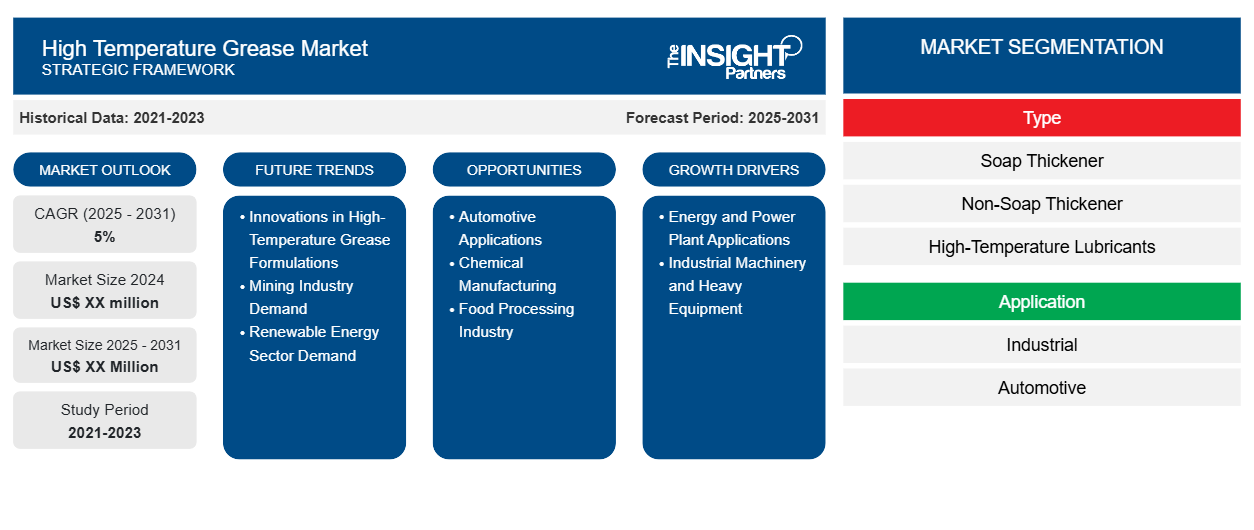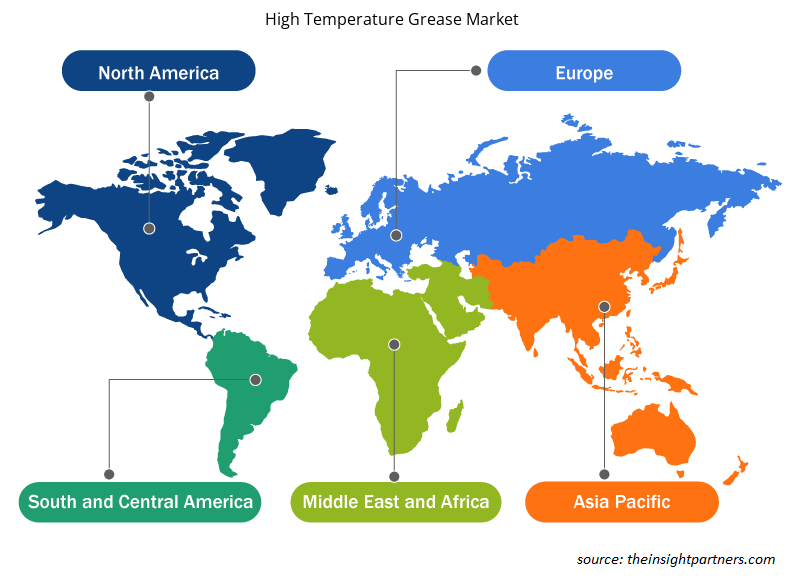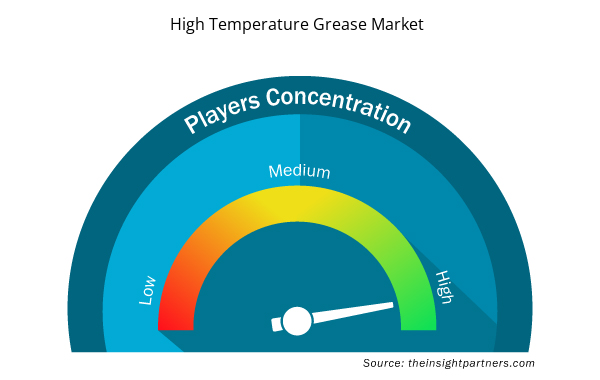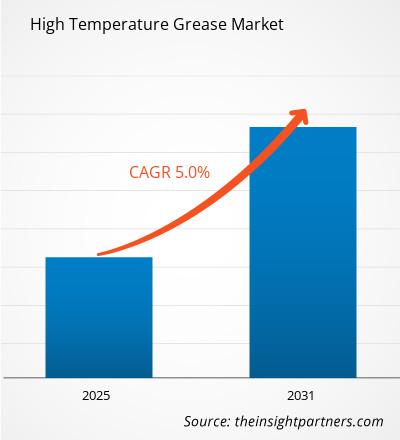Se espera que el mercado de grasas de alta temperatura registre una CAGR del 5 % entre 2025 y 2031, con un tamaño de mercado que se expandirá de US$ XX millones en 2024 a US$ XX millones en 2031.
El mercado de grasas para altas temperaturas se analiza por tipo (espesante de jabón, espesante sin jabón, lubricantes para altas temperaturas), aplicación (industrial, automotriz) y ubicación geográfica (Norteamérica, Europa, Asia Pacífico, Oriente Medio y África, y Sudamérica y Centroamérica). La grasa para altas temperaturas es una grasa multipropósito de alto rendimiento con excelente estabilidad mecánica y térmica en un amplio rango de temperaturas. Además, presenta propiedades de extrema presión, resistencia al agua y antidesgaste. Estas características garantizan una larga integridad del producto y permiten intervalos de relubricación más largos con un mantenimiento mínimo. La grasa para altas temperaturas se utiliza ampliamente en aplicaciones industriales y automotrices, como cojinetes antifricción, lubricación de maquinaria general, bombas de agua y equipos agrícolas, entre otros.
Propósito del Informe
El informe "Mercado de Grasas para Altas Temperaturas" de The Insight Partners busca describir el panorama actual y el crecimiento futuro, los principales factores impulsores, los desafíos y las oportunidades. Esto proporcionará información a diversas partes interesadas del negocio, como:
- Proveedores/Fabricantes de Tecnología: Para comprender la dinámica cambiante del mercado y conocer las oportunidades potenciales de crecimiento, lo que les permitirá tomar decisiones estratégicas informadas.
- Inversores: Realizar un análisis exhaustivo de tendencias respecto a la tasa de crecimiento del mercado, las proyecciones financieras del mercado y las oportunidades que existen en toda la cadena de valor.
- Organismos reguladores: Regular las políticas y las actividades policiales en el mercado con el objetivo de minimizar el abuso, preservar la confianza de los inversores y defender la integridad y estabilidad del mercado.
Segmentación del mercado de grasas para altas temperaturas
Tipo
- Espesante de jabón
- Espesante sin jabón
- Lubricantes de alta temperatura
Solicitud
- Industrial
- Automotor
Personalice este informe según sus necesidades
Obtendrá personalización en cualquier informe, sin cargo, incluidas partes de este informe o análisis a nivel de país, paquete de datos de Excel, así como también grandes ofertas y descuentos para empresas emergentes y universidades.
Mercado de grasas para altas temperaturas: Perspectivas estratégicas

- Obtenga las principales tendencias clave del mercado de este informe.Esta muestra GRATUITA incluirá análisis de datos, desde tendencias del mercado hasta estimaciones y pronósticos.
Factores que impulsan el crecimiento del mercado de grasas de alta temperatura
- Aplicaciones en energía y centrales eléctricas: Demanda de la industria aeroespacial: La expansión de la industria aeroespacial exige grasas para motores de aeronaves y componentes de alto rendimiento, como los que componen el tren de aterrizaje, en condiciones extremas de temperatura. Estas grasas proporcionan una lubricación superior y son esenciales para el mantenimiento y la seguridad de cualquier aeronave comercial o militar.
- Maquinaria industrial y equipo pesado: Los lubricantes a altas temperaturas son importantes en la fabricación y el mantenimiento de maquinaria industrial, como turbinas, compresores y equipos de alta velocidad. Dado el aumento de la producción industrial en todo el mundo, especialmente en los sectores de energía, metalmecánica y maquinaria pesada, ha aumentado la demanda de lubricantes fiables y resistentes al calor.
- Las grasas para altas temperaturas se utilizan ampliamente en centrales eléctricas, incluyendo turbinas de vapor, bombas y motores, y se emplean para garantizar un funcionamiento suave en rangos de alta temperatura. Con el crecimiento de la producción de energía a nivel mundial, principalmente de fuentes renovables, estos lubricantes especializados tendrán una mayor demanda, especialmente en los sectores energéticos.
Tendencias futuras del mercado de grasas para altas temperaturas
- Innovaciones en formulaciones de grasas para altas temperaturas: Las innovaciones en formulaciones de grasas para altas temperaturas incluyen aceites sintéticos, grasas de complejo de litio y grasas a base de arcilla, entre otras. Los avances en estas tecnologías impulsan el mercado, ya que las industrias buscan productos más duraderos y resistentes para aplicaciones de alta temperatura y alta presión.
- Demanda de la industria minera: Las grasas de alta temperatura se utilizan ampliamente en la industria minera, especialmente donde los equipos están expuestos a temperaturas extremadamente altas y condiciones de trabajo agresivas. A medida que la actividad minera mundial continúa creciendo, con la creciente demanda de metales y minerales, también crece la demanda de grasas de alto rendimiento para equipos de minería y maquinaria pesada.
- Demanda del sector de las energías renovables: Con el auge de las fuentes de energía renovables, como la eólica y la solar, las grasas de alta temperatura se vuelven necesarias para componentes como turbinas y cajas de engranajes debido a las pésimas condiciones en las que deben operar. El impulso del sector de las energías renovables incrementa la demanda de lubricantes especiales que soporten temperaturas extremas y garanticen la fiabilidad de los sistemas energéticos.
Oportunidades de mercado para grasas de alta temperatura
- Aplicaciones automotrices: Existen grasas y lubricantes de alta temperatura disponibles en el mercado, los cuales se utilizan con mayor frecuencia en aplicaciones automotrices, incluyendo componentes de motor, pastillas de freno, rodamientos y cualquier otro componente propenso a temperaturas y fricción extremas. Además, la fabricación de automóviles de alto rendimiento y bajo consumo de combustible impulsa la necesidad de grasas de alta temperatura durante el proceso de producción automotriz.
- Fabricación de productos químicos: Estas grasas se utilizan en la fabricación de productos químicos, por ejemplo, en reactores, mezcladores y transportadores de alta temperatura, especialmente en la creciente industria química, sobre todo en las economías emergentes. La creciente demanda de grasas que soporten temperaturas extremas y mantengan su rendimiento bajo presión impulsa el crecimiento del mercado.
- Industria de procesamiento de alimentos: Las grasas de alta temperatura fabricadas según estándares de calidad alimentaria se utilizan en la industria de procesamiento de alimentos (incluyendo la cocción, la repostería y la esterilización), cuyos procesos pueden generar altas temperaturas con el uso de maquinaria. Es probable que la expansión de la producción y el procesamiento de alimentos en todo el mundo impulse la demanda de lubricación resistente al calor y segura para los alimentos en las plantas de fabricación.
Perspectivas regionales del mercado de grasas para altas temperaturas
Los analistas de Insight Partners han explicado detalladamente las tendencias y los factores regionales que influyen en el mercado de grasas para altas temperaturas durante el período de pronóstico. Esta sección también analiza los segmentos y la geografía del mercado de grasas para altas temperaturas en Norteamérica, Europa, Asia Pacífico, Oriente Medio y África, y Sudamérica y Centroamérica.

- Obtenga los datos regionales específicos para el mercado de grasas de alta temperatura
Alcance del informe de mercado de grasas para altas temperaturas
| Atributo del informe | Detalles |
|---|---|
| Tamaño del mercado en 2024 | US$ XX millones |
| Tamaño del mercado en 2031 | US$ XX millones |
| CAGR global (2025-2031) | 5% |
| Datos históricos | 2021-2023 |
| Período de pronóstico | 2025-2031 |
| Segmentos cubiertos | Por tipo
|
| Regiones y países cubiertos | América del norte
|
| Líderes del mercado y perfiles de empresas clave |
|
Densidad de actores del mercado de grasas de alta temperatura: comprensión de su impacto en la dinámica empresarial
El mercado de grasas para altas temperaturas está en rápido crecimiento, impulsado por la creciente demanda del usuario final debido a factores como la evolución de las preferencias de los consumidores, los avances tecnológicos y un mayor conocimiento de los beneficios del producto. A medida que aumenta la demanda, las empresas amplían su oferta, innovan para satisfacer las necesidades de los consumidores y aprovechan las tendencias emergentes, lo que impulsa aún más el crecimiento del mercado.
La densidad de actores del mercado se refiere a la distribución de empresas o compañías que operan en un mercado o sector en particular. Indica cuántos competidores (actores del mercado) hay en un mercado determinado en relación con su tamaño o valor total.
Las principales empresas que operan en el mercado de grasas de alta temperatura son:
- BP plc
- Corporación Chevron
- EI du Pont de Nemours y Cía.
- Corporación Exxon Mobil
- FUCHS PETROLUB SE
Descargo de responsabilidad : Las empresas enumeradas anteriormente no están clasificadas en ningún orden particular.

- Obtenga una descripción general de los principales actores clave del mercado de grasas para altas temperaturas
Puntos clave de venta
- Cobertura integral: el informe cubre de manera integral el análisis de productos, servicios, tipos y usuarios finales del mercado de grasas de alta temperatura, proporcionando un panorama holístico.
- Análisis de expertos: el informe se compila con base en el conocimiento profundo de expertos y analistas de la industria.
- Información actualizada: El informe asegura relevancia comercial debido a su cobertura de información reciente y tendencias de datos.
- Opciones de personalización: este informe se puede personalizar para satisfacer los requisitos específicos del cliente y adaptarse adecuadamente a las estrategias comerciales.
Por lo tanto, el informe de investigación sobre el mercado de grasas para altas temperaturas puede ayudar a descifrar y comprender el panorama de la industria y sus perspectivas de crecimiento. Si bien existen algunas preocupaciones válidas, las ventajas generales de este informe suelen superar las desventajas.
- Análisis histórico (2 años), año base, pronóstico (7 años) con CAGR
- Análisis PEST y FODA
- Tamaño del mercado Valor/volumen: global, regional, nacional
- Industria y panorama competitivo
- Conjunto de datos de Excel



Report Coverage
Revenue forecast, Company Analysis, Industry landscape, Growth factors, and Trends

Segment Covered
This text is related
to segments covered.

Regional Scope
North America, Europe, Asia Pacific, Middle East & Africa, South & Central America

Country Scope
This text is related
to country scope.
Preguntas frecuentes
The North America market is expected to account for the highest CAGR during the forecast period owing to the growing aerospace industry in the region.
The industrial application segment accounted for the largest market share in 2023
BP plc, Chevron Corporation, E. I. du Pont de Nemours and Company, Exxon Mobil Corporation, FUCHS PETROLUB SE, PETRONAS Lubricants International, Shell International B.V., Sinopec Corp., The Lubrizol Corporation, and Total S.A. are some of the key players in the market.
Growing demand from aerospace industry is a key driver in the market
The High-Temperature Grease Market is estimated to witness a CAGR of 5% from 2023 to 2031
Advancements in chemicals technology is an emerging trend in the market.
Trends and growth analysis reports related to Chemicals and Materials : READ MORE..
1.BP plc
2.Chevron Corporation
3.E. I. du Pont de Nemours and Company
4.Exxon Mobil Corporation
5.FUCHS PETROLUB SE
6.PETRONAS Lubricants International
7.Shell International B.V.
8.Sinopec Corp.
9.The Lubrizol Corporation
10.Total S.A.
The Insight Partners performs research in 4 major stages: Data Collection & Secondary Research, Primary Research, Data Analysis and Data Triangulation & Final Review.
- Data Collection and Secondary Research:
As a market research and consulting firm operating from a decade, we have published and advised several client across the globe. First step for any study will start with an assessment of currently available data and insights from existing reports. Further, historical and current market information is collected from Investor Presentations, Annual Reports, SEC Filings, etc., and other information related to company’s performance and market positioning are gathered from Paid Databases (Factiva, Hoovers, and Reuters) and various other publications available in public domain.
Several associations trade associates, technical forums, institutes, societies and organization are accessed to gain technical as well as market related insights through their publications such as research papers, blogs and press releases related to the studies are referred to get cues about the market. Further, white papers, journals, magazines, and other news articles published in last 3 years are scrutinized and analyzed to understand the current market trends.
- Primary Research:
The primarily interview analysis comprise of data obtained from industry participants interview and answers to survey questions gathered by in-house primary team.
For primary research, interviews are conducted with industry experts/CEOs/Marketing Managers/VPs/Subject Matter Experts from both demand and supply side to get a 360-degree view of the market. The primary team conducts several interviews based on the complexity of the markets to understand the various market trends and dynamics which makes research more credible and precise.
A typical research interview fulfils the following functions:
- Provides first-hand information on the market size, market trends, growth trends, competitive landscape, and outlook
- Validates and strengthens in-house secondary research findings
- Develops the analysis team’s expertise and market understanding
Primary research involves email interactions and telephone interviews for each market, category, segment, and sub-segment across geographies. The participants who typically take part in such a process include, but are not limited to:
- Industry participants: VPs, business development managers, market intelligence managers and national sales managers
- Outside experts: Valuation experts, research analysts and key opinion leaders specializing in the electronics and semiconductor industry.
Below is the breakup of our primary respondents by company, designation, and region:

Once we receive the confirmation from primary research sources or primary respondents, we finalize the base year market estimation and forecast the data as per the macroeconomic and microeconomic factors assessed during data collection.
- Data Analysis:
Once data is validated through both secondary as well as primary respondents, we finalize the market estimations by hypothesis formulation and factor analysis at regional and country level.
- Macro-Economic Factor Analysis:
We analyse macroeconomic indicators such the gross domestic product (GDP), increase in the demand for goods and services across industries, technological advancement, regional economic growth, governmental policies, the influence of COVID-19, PEST analysis, and other aspects. This analysis aids in setting benchmarks for various nations/regions and approximating market splits. Additionally, the general trend of the aforementioned components aid in determining the market's development possibilities.
- Country Level Data:
Various factors that are especially aligned to the country are taken into account to determine the market size for a certain area and country, including the presence of vendors, such as headquarters and offices, the country's GDP, demand patterns, and industry growth. To comprehend the market dynamics for the nation, a number of growth variables, inhibitors, application areas, and current market trends are researched. The aforementioned elements aid in determining the country's overall market's growth potential.
- Company Profile:
The “Table of Contents” is formulated by listing and analyzing more than 25 - 30 companies operating in the market ecosystem across geographies. However, we profile only 10 companies as a standard practice in our syndicate reports. These 10 companies comprise leading, emerging, and regional players. Nonetheless, our analysis is not restricted to the 10 listed companies, we also analyze other companies present in the market to develop a holistic view and understand the prevailing trends. The “Company Profiles” section in the report covers key facts, business description, products & services, financial information, SWOT analysis, and key developments. The financial information presented is extracted from the annual reports and official documents of the publicly listed companies. Upon collecting the information for the sections of respective companies, we verify them via various primary sources and then compile the data in respective company profiles. The company level information helps us in deriving the base number as well as in forecasting the market size.
- Developing Base Number:
Aggregation of sales statistics (2020-2022) and macro-economic factor, and other secondary and primary research insights are utilized to arrive at base number and related market shares for 2022. The data gaps are identified in this step and relevant market data is analyzed, collected from paid primary interviews or databases. On finalizing the base year market size, forecasts are developed on the basis of macro-economic, industry and market growth factors and company level analysis.
- Data Triangulation and Final Review:
The market findings and base year market size calculations are validated from supply as well as demand side. Demand side validations are based on macro-economic factor analysis and benchmarks for respective regions and countries. In case of supply side validations, revenues of major companies are estimated (in case not available) based on industry benchmark, approximate number of employees, product portfolio, and primary interviews revenues are gathered. Further revenue from target product/service segment is assessed to avoid overshooting of market statistics. In case of heavy deviations between supply and demand side values, all thes steps are repeated to achieve synchronization.
We follow an iterative model, wherein we share our research findings with Subject Matter Experts (SME’s) and Key Opinion Leaders (KOLs) until consensus view of the market is not formulated – this model negates any drastic deviation in the opinions of experts. Only validated and universally acceptable research findings are quoted in our reports.
We have important check points that we use to validate our research findings – which we call – data triangulation, where we validate the information, we generate from secondary sources with primary interviews and then we re-validate with our internal data bases and Subject matter experts. This comprehensive model enables us to deliver high quality, reliable data in shortest possible time.

 Obtenga una muestra gratuita de este informe
Obtenga una muestra gratuita de este informe